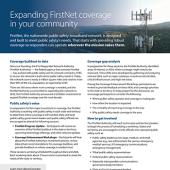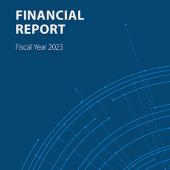When hurricanes strike, many communities become vulnerable to high winds and widespread flooding that can cause injury and damage infrastructure. Communities in a storm’s path are often without power, food, or water for days – and for first responders, the main and immediate focus after a hurricane is rescuing and responding to those in need of aid. Last season, public safety officials relied on new technologies to communicate and monitor hurricane activity. During – and in the aftermath of – these storms, FirstNet sustained and restored emergency communications for many hard-hit communities.
FirstNet was built with innovative solutions that help first responders prepare for emergencies. The network’s Band 14 priority and preemption features give public safety access to reliable, interoperable communication service when they need it most – including hurricane season.
FirstNet flies over Louisiana to support hurricane relief effort
During the 2020 hurricane season, FirstNet extended network coverage in areas hard-hit by storms across Southwest Louisiana. For Statewide Interoperability Coordinator Travis Johnson, who serves in the Louisiana’s Governor’s Office of Homeland Security and Emergency Preparedness, multiple, hard-hitting storms causing widespread flooding, structural damage, and power outages complicated emergency response. “In any normal year, a Cat 2 is nothing to take lightly, but it’s also something we’re prepared to deal with,” said Johnson about the timing of Delta Hurricane. “But this one came across 12 miles east of where Laura made landfall just six weeks later. So obviously, that area in southwest Louisiana just got hammered.”
Responding to storms, federal, state, and local partners relied on FirstNet’s capabilities and coverage enhancements to stay connected. Johnson turned to FirstNet Central to determine where the network was struggling and what communications assets might need to be sent with search and rescue teams in response to Hurricane Laura. “It [FirstNet Central] enabled us to make better decisions about where to send our limited resources.”
Last August as Hurricane Laura moved toward the Gulf Coast, FirstNet provided Louisiana responders with the use of Emergency Drop Kits and the deployment of mobile cell sites. In an emergency, portable drop kits are available to keep first responders in constant communication with each other by surrounding them in a communications bubble. Each “bubble” connects to FirstNet as an interim solution until a FirstNet dedicated deployable asset arrives on the scene.
FirstNet’s fleet of deployable assets is available to FirstNet users free of charge when disasters strike or when planning for a large event. The fleet of over 100 mobile solutions gives FirstNet subscribers access to ground-based solutions like Cell on Wheels (COWs) and Cell on Light Trucks (COLTs) or air-based solutions such as Flying COWs (drones), and FirstNet One, a 55-foot aerostat (blimp).
Hurricane Laura was the first time FirstNet One was used to support disaster recovery. It provided wide-scale portable connectivity to responding agencies. Flying at up to 1,500 feet,
FirstNet One connected voice and data services over a large area, doing the job of multiple ground-based deployables. “That’s [the Aerostat is] a big deal when it comes to coverage area opposed to a normal COW or COLT,” recalled Johnson. “That was a huge benefit to use, not to mention looking really cool.”
Throughout the hurricane response, Johnson and his team used FirstNet to communicate with public safety agencies across multiple jurisdictions. FirstNet’s Push-to-Talk capabilities made it possible to talk with personnel and use mapping tools for improved situational awareness. “This is the first time we ever had this invaluable [mapping] tool,” recalled Johnson. “When I looked at my [Statewide LMR system] map, I knew where we had P25 LMR coverage and then side-by-side, I could pull up FirstNet’s LTE coverage [via FirstNet Central]. That was really important to us and helpful during the decision-making process.”
FirstNet prepared Alabama responders for Hurricane Sally
For Cherokee County’s Emergency Management Director Shawn Rogers, handling weather events can be a weekly ordeal in the northeast corner of Alabama. Cherokee County uses FirstNet’s interoperable communications to connect with partner agencies along the Georgia border, in four neighboring counties, and around Weiss Lake’s 447-mile shoreline.
When Hurricane Sally made landfall in Alabama last September, Rogers and a five-member team deployed to Baldwin County to assist with a seven-day response operation. With a FirstNet SatCOLT set up outside the county’s Emergency Operations Center, response crews connected to the network’s extended coverage and capacity to power all FirstNet connected devices (e.g., tablets, smart phones, mobile hotspot) and essential online services like mobile chat, document transfers, and video connections. “I was very pleased - we didn’t have any issues whatsoever, and everything was able to flow,” said Rogers. “We were able to build databases and share information just as FirstNet was intended to enable us to do. It was a very good experience with the first hurricane deployment I had in 2020.”
FirstNet connects Texas City’s essential community partners
Each hurricane season, first responders throughout Texas consider preparedness an important and necessary component of maintaining the public’s safety. In 2020, the Gulf Coast experienced a relentless string of storms from tropical storms Cristobal and Marco to hurricanes Laura, Delta, and Zeta. When disasters like this strike, Texas City’s public safety agencies rely on a vast number of extended community partners to relay essential and potentially life-saving information.
To prepare for hurricane season, Texas City uses the FirstNet Uplift Tool to provide temporary FirstNet access to its key partners with the ability to reach deep into the community. When Texas City served as an evacuation point during last summer’s back-to-back hurricanes, Emergency Manager and Homeland Security Director Thomas Munoz uplifted FirstNet service to the Red Cross, the Salvation Army, the Gulf Coast Transit District and many other partners throughout the area. Using FirstNet prioritized network and services, the Texas City sent critical information (e.g., weather alerts, power outages, shelter information, road conditions) to their partners, and in turn this information was shared with the wider community. “One of the things we love about working with FirstNet is the fact that not everybody has the same cell phone capabilities,” explained Munoz. “That’s how FirstNet works with us – getting together all these community partners and providing the same communication.”
Each year, FirstNet stands ready to support public safety agencies and organizations during hurricane season. FirstNet is critical to our nation’s first responders who battle storms day in and day out – and to those who have placed their confidence into the network’s communications capabilities to keep our communities safe.




















